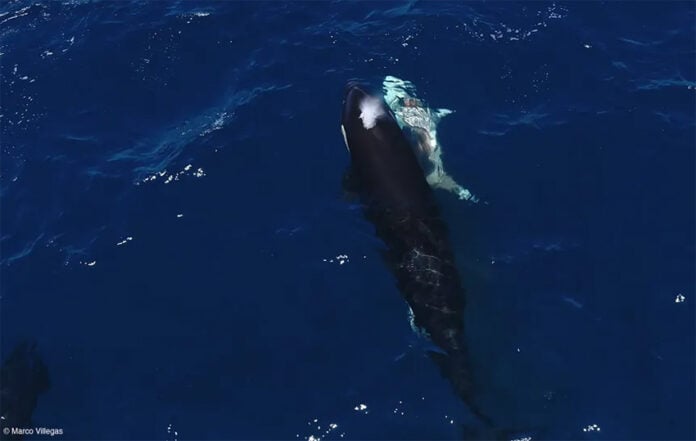Killer whales in northern Mexico waters have been in the spotlight this week after scientists documented them attacking young great white sharks and devouring their energy-rich livers — a phenomenon previously thought to be limited to South Africa.
“In Mexico, Killer Whales Take Down Great White Sharks,” beamed a headline in the New York Times.
@cbsnews Orcas have been seen off the coast of Mexico hunting young great white sharks by flipping them over to incapacitate them before eating their liver. Researchers studying the orca pod say this group specializes in hunting sharks. The orcas are seen on newly-released video turning a shark upside down, which paralyzes the shark after altering its awareness of its surroundings. Then, with the shark in a vulnerable position, they eat its energy-filled liver. #orcas #sharks #mexico
“Orcas in Mexico Have Learned to Attack Young Great White Sharks — by Flipping Them Upside Down and Eating Their Livers,” heralded Smithsonian magazine.
Video evidence captured by marine biologist Erick Higuera has revealed how the killer whales, aka orcas, in the so-called Moctezuma pod coordinate their attacks against juvenile great whites, turning them upside down to induce tonic immobility (a natural state of paralysis), then slicing them open to extract their livers.
“I saw [on the video] that the shark had the liver hanging out on the side, already popped off. And a few minutes later, they came up with the liver in their mouth,” Higuera recalled.
The documented hunts, published Sunday, Nov. 2 in the journal Frontiers in Marine Science, occurred in 2020 and 2022 near La Paz, the capital of Baja California Sur.
“Impossible! It’s a great white shark. Where is it from? South Africa? No, my friend, it’s here in La Paz,” Higuera recounted, describing the moment he confirmed the species on video.
Orcas have specialized hunting techniques that vary by region and prey — such as leaping five meters into the air to attack bottlenose dolphins, as documented by Mexico News Daily in 2021.
But hunting young great white sharks showcases an adaptation new to science.
In the waters off South Africa, the orcas hunt mainly adults, both for a greater quantity of food and to eliminate competition for the same prey, according to Scientific American.
“We suggest that juvenile great white sharks may be, if they aren’t already, a seasonal targeted prey for these orcas,” Higuera explained.
Researchers said they suspect climate change and warming waters — potentially linked to El Niño — may be bringing more great white juveniles into the Gulf of California, also known as the Sea of Cortez, giving the Moctezuma pod more opportunity to hunt them.
View this post on Instagram
“We actually are seeing more presence of great white sharks in the Gulf of California in the last 10 years,” said study coauthor Francesca Pancaldi.
The orcas’ focus on the sharks’ livers — which constitute a quarter of a shark’s body and provide high concentrations of vitamins A and D as well as toxic substances (which is why humans don’t eat them) — demonstrates the animals’ intelligence and dietary efficiency.
“It’s the only thing that’s really worth it for their time,” Taylor Chapple, a marine ecologist at Oregon State University who was not involved with the research told the New York Times. “It’s sort of like they’re going for the cheeseburger surrounded by a bunch of celery.”
While orcas’ predation on white sharks has disrupted ecosystems in the waters off South Africa — leading sharks to abandon traditional aggregation sites — Mexican scientists say continued monitoring is essential as the Gulf’s marine dynamics shift.
With reports from El País, La Tercera and NBC News
